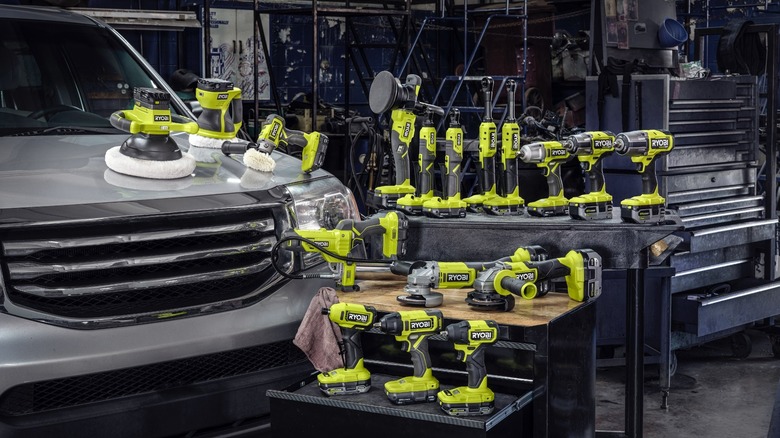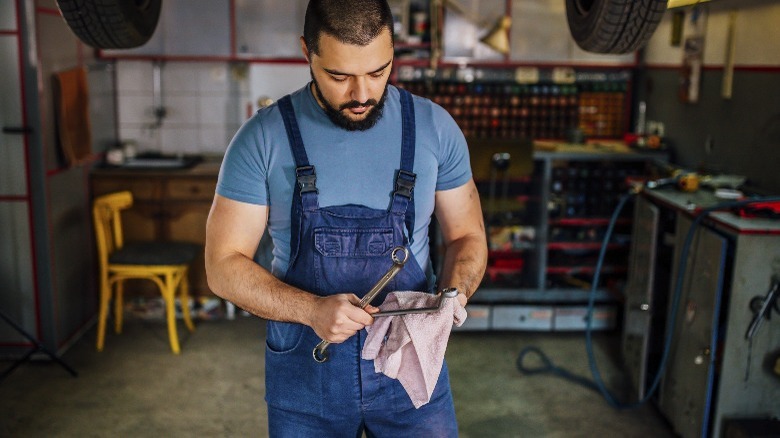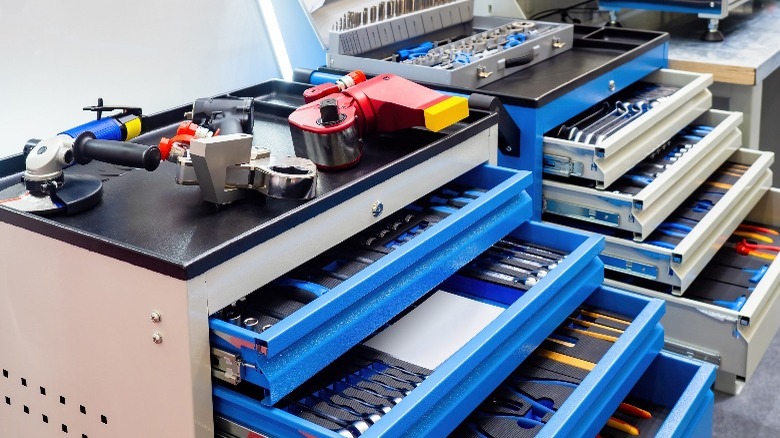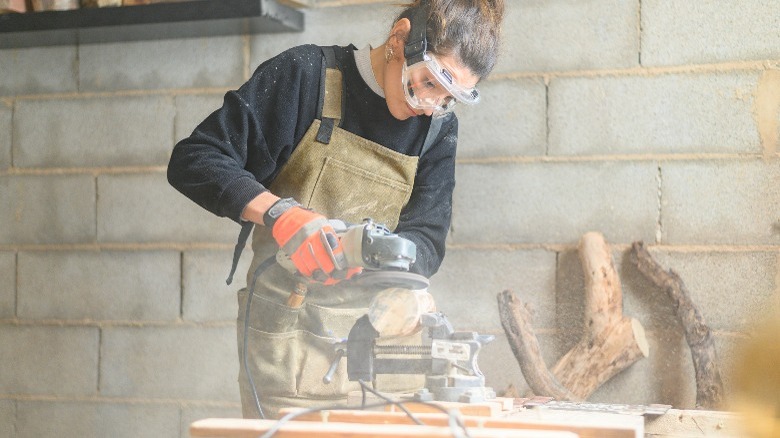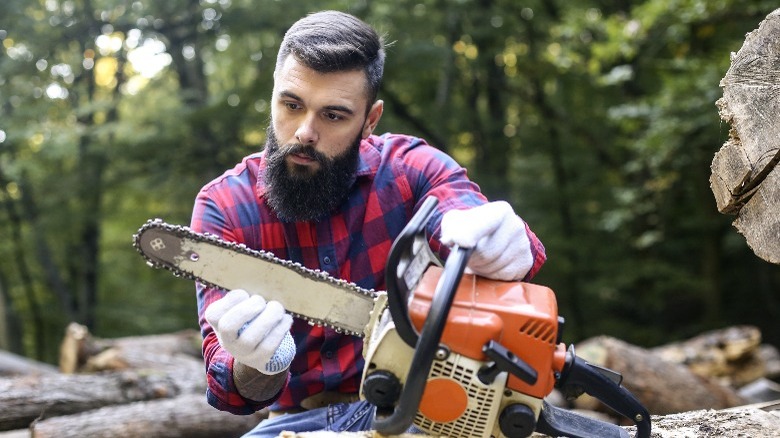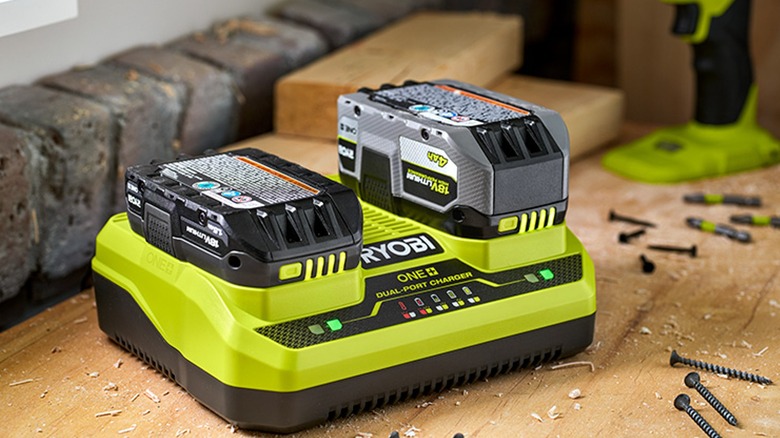Tips To Maintain Your Ryobi Power Tools For Long-Lasting Performance
If you're a tradesperson, avid DIYer, or a casual tool enthusiast, you've probably heard of Ryobi power tools. Ryobi is one of the best power tool brands on the market today. The company manufactures an extensive lineup of tools for various applications and industries, and it even has an exciting roster of new tools for 2024. Ryobi is known as a mid-level brand. It supplies products that are suitable for both pros and novices, and its prices fall somewhere between the economy and professional tiers. While Ryobi's prices are lower than many competitor brands, building a collection of Ryobi power tools can still be costly. Because of that, it's vital that you maintain your tools properly to protect your investment.
But how exactly do you maintain Ryobi power tools? It may seem obvious, but one of the most basic things you can do to protect your tools is to treat them with care and respect. Following that, it's vital that you clean your tools regularly and store them in a safe location. Those aren't the only things you should do to protect your tools, but they are some of the simplest and most fundamental steps to safeguard your investment and ensure that you get many years of service from your devices. Let's dive in and explore some ways to protect your tools in greater detail. Here are five tips to maintain your Ryobi power tools for long-lasting performance.
Keep them clean
One of the most fundamental ways to protect your Ryobi power tools is to keep them clean. Look, we understand that tools get dirty, and it's not always possible to avoid dust, grime, and even fluids. But the point is that once you finish your project, you should clean your tools the right way before storing them. That doesn't just include wiping down the superficial surfaces. You need to clean your tools meticulously. That means cleaning the cracks and crevices around mating surfaces for batteries or attachments and removing any caustic chemical residue.
Each time you wrap up a job, we recommend wiping your tools down to remove any dust or grime. You can use things like baby wipes or Arm & Hammer wipes to clean your tools, as these products are designed to be gentle and don't contain harsh chemicals that may damage your devices. Remember to be detailed when cleaning your Ryobi power tools. Check inside drill chucks, between battery mating surfaces, and within any moving parts or joints to ensure you remove all grime and debris. If you use water or a wet wipe to clean your tools, dry them thoroughly before storing them. Protecting your tools in this way can help you avoid damage — like corrosion or seized parts — and premature failure.
Store them properly
Another critical way to maintain your tools and keep them safe is to store them properly. Each time you finish using your Ryobi products, you should first clean them. But cleaning your tools is only the first step. After you clean your devices thoroughly, you need to store them in a safe, dry environment. That means don't leave your tools lying around outside, on the shop floor, or anywhere wet, humid, or too hot.
If you leave your tools at your workplace, you may want to consider investing in a locking storage option like a toolbox or tool chest. Failing to store your tools properly leaves them exposed to the elements, unauthorized users, insects, and pests and puts them at risk of falling and getting damaged or lost. Even if you think it's unnecessary, locking your tools up in a safe place can give you peace of mind. If you know your tools are stored securely in a safe location, you don't have to worry about walking into the shop to discover a broken or missing tool.
Use them correctly
It may seem like common sense, but using your tools correctly is one of the primary ways to prevent damage. Ryobi does sell various tools that do more than just one job. But that doesn't mean that all Ryobi devices are multi-use. Even if you own some of those Ryobi tools with multiple applications, you still need to use them properly. Trying to use your drill as a hammer or your reciprocating saw as a pry bar just won't work, and it will most likely cause severe damage that may or may not be repairable.
Instead of trying to invent new ways to use your Ryobi power tools, you should follow the manufacturer's instructions to a tee. Ryobi designs each tool with a few intended purposes; even the most robust device can only tolerate so much misuse. If you want your tools to last for the long haul and provide years of reliable service, you need to use them as they're intended to be used. That not only means don't use your tools for something they're obviously not designed for — like trying to use your drill as a hammer — but it also means respecting the tool's limitations. Pushing your tools too hard is a great way to cause premature damage. If you care about your investment, you need to follow Ryobi's instructions and avoid pushing your devices past their limits.
Inspect them regularly
Another smart way to protect your Ryobi power tools is to inspect them regularly. We don't mean just giving your tools a cursory glance every now and then. Instead, spend a little bit of time each month inspecting each of your devices for defects and damage. We recommend checking your tools as part of a cleaning routine. Yes, we know that we already mentioned that you should clean your tools after each use, and that remains true. But it's also not a bad idea to set aside a few hours each month to perform a deep cleaning and inspect your devices.
You may not be able to disassemble your tools due to the warranty. However, that doesn't mean you can't remove all unnecessary attachments and batteries for a solid detailing session. This is the time when you should remove any protective covers, disconnect batteries, and detach any superficial parts that don't involve voiding the warranty. You can clean metal pieces with alcohol or a degreaser. For plastic and rubber, try using baby wipes or something gentle like dish soap, but remember to avoid getting sensitive electrical components wet.
Throughout this process, you should be inspecting each component religiously. Look for any signs of damage or weakness that may cause the tool to fail or malfunction. If the damage is severe, you may need to replace your tool to avoid harming yourself or your projects. If there's minor damage, you may be able to repair your tools using something like duct tape or glue. But remember, your Ryobi tools may have a warranty. So, if a tool is damaged, try to get a replacement before repairing it yourself or tossing it in the trash.
Protect your batteries
Batteries are one of the most critical components for many Ryobi power tools. It's no secret that batteries can be both expensive and sensitive. However, since power tools generally have a reputation for being rugged and capable of withstanding a lot of abuse many people neglect their batteries.
Some of the best ways to protect your Ryobi batteries include storing them in dry areas, allowing them to die completely before recharging, removing them from the charger after they reach 100%, and avoiding leaving them in places that are extremely cold or hot. You should also remember to pay special attention to your batteries during your cleaning and inspection routines. Batteries can contain a lot of toxic materials, and if one becomes damaged, those materials may seep out onto your clothing and skin. Anytime you notice battery damage, you should proceed with extreme caution. Even though they can be expensive, it's better to replace a faulty battery than to continue using it and risk injuring yourself or others.
